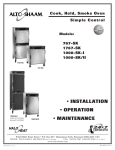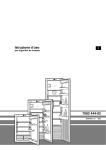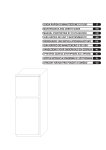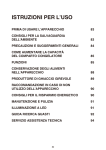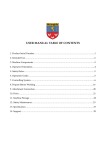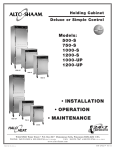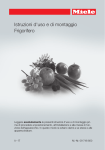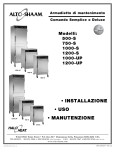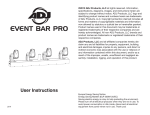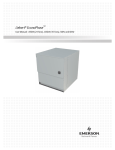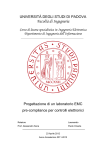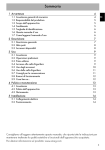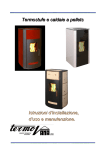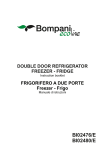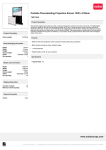Download guida rapida di manutezione e d`uso it maintenance and user`s
Transcript
GUIDA RAPIDA DI MANUTEZIONE E D’USO IT MAINTENANCE AND USER’S GUIDE EN ITALIANO pag. 1--10 Grazie per l‘acquisto di questo frigorifero, realizzato con tecnologie all‘avanguardia, che garantiscono un facile utilizzo nel rispetto della natura. Vi consigliamo un‘attenta lettura di questa guida rapida e della scheda tecnica per familiarizzare con il Vostro nuovo frigorifero. ENGLISH pg. 11--20 Congratulations on purchasing this fridge, which has been designed using the latest technologies for an easy-to-use, environmentally friendly appliance. We recommend you read this guide and the technical datasheet carefully to find out everything you need to know about your new fridge. INDICE IT INFORMAZIONI PER LA SICUREZZA ................................ 2--2 INSTALLAZIONE .................................................................. 3--3 USO........................................................................................ 3--3 CONSERVAZIONE ................................................................ 4--4 CONGELAMENTO ................................................................ 5--5 SBRINAMENTO .................................................................... 5--5 MANUTENZIONE E PULIZIA ................................................ 6--6 RISPARMIO ENERGETICO .................................................. 6--6 RIDUZIONE DELLA RUMOROSITÀ .................................... 6--6 SPORTELLO REVERSIBILE ................................................ 6--7 DIMENSIONI DEL PRODOTTO E COMPARTIMENTO INTEGRATO .......................................................................... 7--8 INSTALLAZIONE DELL'ELETTRODOMESTICO A INCASSO.. 8--8 ABBINAMENTO DEI PANNELLI DELLA COLONNA DI INCASSO AGLI SPORTELLI DELL'ELETTRODOMESTICO .. 9--9 PRECAUZIONI PER L'USO CORRETTO ............................ 9--9 INUTILIZZO TEMPORANEO DELL'ELETTRODOMESTICO .. 9--9 SOLUZIONE DEI PROBLEMI................................................ 10--10 IT 1 Grazie per aver acquistato questo prodotto. Prima di utilizzare il frigorifero, leggere attentamente questo manuale di istruzioni per ottimizzare il funzionamento dell'elettrodomestico. Conservare tutta la documentazione per future consultazioni o per altri proprietari. Questo prodotto è destinato esclusivamente all'uso domestico o applicazioni simili, ad esempio: - area cucina per il personale in negozi, uffici e altri ambienti di lavoro, - aziende agricole, hotel, motel, - bed & breakfast per l'uso da parte dei clienti, altri ambienti residenziali, - servizi di catering e altri impieghi diversi dalla vendita al dettaglio. Questo elettrodomestico deve essere utilizzato esclusivamente per la conservazione di alimenti. Altri utilizzi sono pericolosi e il produttore non sarà responsabile di tali rischi. Si raccomanda di consultare le condizioni della garanzia. INFORMAZIONI PER LA SICUREZZA Il frigorifero contiene gas refrigerante (R600a: isobutano) e gas isolante (ciclopentano) ecocompatibili ma comunque infiammabili. Per evitare rischi attenersi scrupolosamente alle seguenti istruzioni: • Prima di qualunque intervento, staccare dalla presa la spina del cavo di alimentazione. • L'impianto di refrigerazione collocato nella parte posteriore e nella parte interna del frigorifero contiene refrigerante. Per tale motivo, evitare con attenzione di danneggiare i tubi. • In caso di perdita nell'impianto di refrigerazione, non toccare la presa di corrente ed evitare l'uso di fiamme libere. Aprire la finestra e arieggiare l'ambiente. Rivolgersi al centro assistenza per chiedere la riparazione. • Non adoperare coltelli o oggetti appuntiti per rimuovere brina o ghiaccio. Tali oggetti possono danneggiare il circuito del refrigerante ed eventuali fuoriuscite potrebbero provocare danni agli occhi o incendi. • Non installare l'elettrodomestico in luoghi umidi, unti o polverosi, e non esporlo all'acqua e alla luce solare diretta. • Non installare l'elettrodomestico accanto a caloriferi o materiali infiammabili. • Non adoperare adattatori né cavi di prolunga. • Non tirare o piegare eccessivamente il cavo di alimentazione e non toccare la spina con le mani umide. • Per scongiurare il rischio di incendi o scosse elettriche, non danneggiare la spina e/o il cavo di alimentazione. • Mantenere pulita la presa di corrente in quanto l'eccesso di residui di polvere può causare incendi. • Non adoperare dispositivi meccanici o altre apparecchiature per accelerare il processo di sbrinamento. • Evitare assolutamente l'uso di fiamme libere o apparecchiature elettriche (ad es. riscaldatori, pulitrici a vapore, candele, lampade a olio e altri strumenti simili) per accelerare la fase di sbrinamento. • Non adoperare né conservare spray infiammabili (ad esempio bombolette di vernice spray) accanto al frigorifero, in quanto potrebbero causare incendi o esplosioni. • Non adoperare apparecchiature elettriche all'interno dei comparti per la conservazione degli alimenti, a meno che non siano del tipo consigliato dal produttore. • Non conservare in frigorifero materiali infiammabili o ad elevata volatilità (ad es. etere, benzina, GPL, propano, bombolette spray, adesivi, alcool puro ecc.), in quanto possono causare esplosioni. • Non conservare medicinali o materiali di ricerca nel frigorifero. Quando si conserva un materiale che richiede un rigido controllo della temperatura di conservazione, tale materiale potrebbe deteriorarsi o produrre reazioni incontrollate potenzialmente pericolose. • Mantenere libere da ostruzioni le aperture di ventilazione sull'involucro del frigorifero o nella struttura a incasso. • Non collocare oggetti e/o contenitori pieni d'acqua sopra l'elettrodomestico. • Non eseguire riparazioni del frigorifero. Tutti i tipi di intervento devono essere effettuati esclusivamente da personale qualificato. • L'elettrodomestico può essere utilizzato da bambini di almeno 8 anni e da persone con ridotte capacità fisiche, sensoriali, mentali o prive di esperienza solo se sono state istruite all'uso, hanno ricevuto adeguate istruzioni per adoperare l'elettrodomestico in sicurezza e sono perfettamente consapevoli dei pericoli. Impedire ai bambini di giocare con l'elettrodomestico. La pulizia e la manutenzione non devono essere effettuate dai bambini in assenza di sorveglianza. Ruotando la manopola fino alla fine in senso antiorario, si sente uno scatto indicante che il prodotto è spento. Dopo l'installazione dell'elettrodomestico, il cavo elettrico e la presa di corrente devono essere facilmente accessibili. La presa deve essere compatibile con la spina dell'elettrodomestico. In caso contrario, rivolgersi a un tecnico autorizzato affinché provveda alla sostituzione della spina. Non adoperare prolunghe né prese multiple. Non toccare le parti interne o gli alimenti congelati con le mani bagnate o umide per evitare bruciature. IT 2 Smaltimento del vecchio elettrodomestico Il prodotto deve essere smaltito correttamente per evitare potenziali danni all'ambiente e alla salute umana causati dallo smaltimento inappropriato del prodotto al termine della sua ciclo di vita. Il corretto smaltimento dell'elettrodomestico consente di recuperare preziose materie prime! Sull'unità è riportato il simbolo di conformità alla direttiva europea 2012/19/CE sullo smaltimento di apparecchiature elettriche ed elettroniche di scarto (WEEE). Il simbolo sul prodotto indica che questo elettrodomestico non può essere gestito come un normale rifiuto domestico, ma deve essere consegnato al punto di raccolta più vicino per il riciclo delle apparecchiature elettriche ed elettroniche. Lo smaltimento deve essere effettuato in conformità alle normative locali in materia di smaltimento dei rifiuti. Per informazioni più dettagliate sulla gestione, sul recupero e sul riciclo del prodotto, rivolgersi all'ufficio pubblico competente, alla società responsabile dello smaltimento dei rifiuti urbani o al rivenditore da cui è stato acquistato l'elettrodomestico. Tagliare e smaltire il cavo di alimentazione con la spina. Non danneggiare i tubi prima dello smaltimento, in quanto contengono gas refrigerante. Per lo smaltimento dell'imballaggio, attenersi alle normative locali. Le apparecchiature elettriche ed elettroniche di scarto contengono sostanze inquinanti (pericolose per l'ambiente) e componenti che possono essere riutilizzati. Le apparecchiature elettriche ed elettroniche di scarto devono essere sottoposte a specifici trattamenti per rimuovere e smaltire in modo appropriato tutte le sostanze inquinanti e per recuperare e riciclare i materiali. Tutti gli utenti possono contribuire a evitare che le apparecchiature elettriche ed elettroniche di scarto diventino un problema ambientale seguendo alcune regole di base: -Le apparecchiature elettriche ed elettroniche di scarto non devono essere gestite come rifiuti domestici. -Le apparecchiature elettriche ed elettroniche di scarto devono essere consegnate ai punti di raccolta pertinenti gestiti dai Comuni o da società regolarmente registrate. In molti paesi, per le apparecchiature elettriche ed elettroniche di scarto di grandi dimensioni è prevista la raccolta a domicilio. - Quando si acquista un nuovo elettrodomestico, quello vecchio può essere restituito al rivenditore che è tenuto a prelevarlo gratuitamente alla consegna di quello nuovo, purché sia di tipo equivalente e abbia le stesse funzioni di quello fornito. • La presa è dotata di messa a terra conforme alle norme. • La presa può sopportare il carico elettrico massimo indicato sulla targhetta del frigorifero. • La tensione elettrica rientra nelle specifiche indicate sulla targhetta del frigorifero. • Non piegare né comprimere il cavo. • Il cavo deve essere controllato regolarmente e deve essere sostituito solo da un tecnico autorizzato. • Il produttore declina qualunque responsabilità derivante dall'inosservanza di queste misure di sicurezza. Avvio dell'elettrodomestico Rimuovere tutti gli imballi presenti all'interno dell'elettrodomestico e pulirlo con acqua e bicarbonato di sodio o sapone neutro. Dopo l'installazione, attendere 2-3 ore che la temperatura del frigorifero/congelatore si stabilizzi prima di collocarvi alimenti freschi o congelati. Se il cavo di alimentazione si scollega, attendere almeno cinque minuti prima di riavviare il frigorifero/congelatore. A questo punto l'elettrodomestico è pronto all'uso. USO Accensione/spegnimento (senza display) • Il termostato di controllo dell'elettrodomestico è collocato all'interno del comparto frigo (Fig. 1). Ruotare la manopola del termostato oltre la posizione “0”. La luce si accende quando si apre lo sportello del frigorifero. Ruotando la manopola fino a “0”, il prodotto si spegne completamente. Fig. 1 Regolazione della temperatura (senza display) Conformità 5 Le parti di questo elettrodomestico destinate al contatto con prodotti alimentari sono conformi ai requisiti del regolamento CE 1935/2004. L'apparecchiatura è conforme alle direttive europee 2004/1 08/CE, 2006/95CE e successive modifiche. Fig. 2 INSTALLAZIONE AVVERTENZE: • Non installare l'elettrodomestico in luoghi umidi, in quanto l'isolamento potrebbe diminuire e potrebbero verificarsi perdite. Sulle parti esterne del prodotto, inoltre, potrebbe accumularsi condensa. • Non collocare l'elettrodomestico all'aperto o vicino a fonti di calore, e non esporlo alla luce solare diretta. • La regolazione della temperatura per entrambi i comparti si effettua ruotando la manopola del termostato (Fig. 2). Selezionare la posizione desiderata: • Per ridurre la temperatura interna del frigorifero e del congelatore, ruotare la manopola verso la posizione 5. • Per aumentare la temperatura interna del frigorifero e del congelatore, ruotare la manopola verso la posizione 0. Per il corretto funzionamento dell'elettrodomestico, le temperature ambiente devono essere quelle indicate: da +10 a +32 °C per la classe climatica SN da +16 a +32 °C per la classe climatica N da +16 a +38 °C per la classe climatica ST da +16 a +43 °C per la classe climatica T (vedere la targhetta del prodotto) • Non collocare contenitori pieni di liquidi sopra l'elettrodomestico. • Dopo la collocazione dell'elettrodomestico nella sede definitiva, attendere almeno 3 ore prima di metterlo in funzione. Collegamento elettrico Dopo il trasporto, collocare l'elettrodomestico in posizione verticale e attendere almeno 2-3 ore prima di collegarlo all'impianto elettrico. Prima di inserire la spina nella presa elettrica, accertarsi che: IT 3 CONSERVAZIONE • Per preservare il sapore, le proprietà nutritive e la freschezza degli alimenti, è consigliabile conservarli nel comparto frigorifero come mostrato in Fig. 6, avvolgendoli in fogli di alluminio o di plastica o collocandoli in adeguati contenitori chiusi per evitare la contaminazione reciproca. Zona frigorifero Frutta e verdura • Per ridurre la perdita di liquidi della frutta e della verdura, conservare questi prodotti avvolti in materiali plastici, ad esempio pellicole o sacchetti, e collocarli nell'area destinata alla frutta e verdura. In questo modo si evita che si deteriorino rapidamente. ZONA FRIGO Fig. 6 NOTA: Se il frigorifero contiene grandi quantità di alimenti o se lo sportello viene aperto spesso, è normale che l'indicatore non indichi OK. Attendere almeno 10 ore prima di regolare la manopola su un'impostazione più alta. Zona congelatore Consultare la tabella seguente per i vari comparti Il processo di congelamento può avvenire solo nei comparti 2-3 MESI 4-6 MESI 6-8 MESI 10 - 12 MESI Fig.4 Consigli pratici Indicatore della temperatura nella zona più fredda (solo in alcuni modelli) Collocare gli alimenti sui ripiani in modo omogeneo per consentire una corretta circolazione dell'aria e un adeguato raffreddamento. • Evitare il contatto tra gli alimenti e le pareti posteriori del comparto frigorifero. Alcuni modelli sono dotati di un indicatore della temperatura nella zona più fredda del comparto frigorifero per controllare la temperatura media. Questo simbolo indica la zona più fredda del frigorifero (Fig. 5). • Non introdurre cibi caldi perché possono causare il deterioramento degli alimenti presenti e aumentare il consumo energetico. • Rimuovere le confezioni degli alimenti prima di inserirli nel frigo. • Non inserire piatti o altri contenitori senza averli prima lavati. • Non ostruire con gli alimenti le aperture di ventilazione dell'aria fredda. • Per una corretta circolazione dell'aria, non coprire il ripiano in vetro del cassetto della frutta. • Non conservare bottiglie nel comparto congelatore in quanto il congelamento del loro contenuto potrebbe farle scoppiare. • In caso di blackout prolungato, tenere il più possibile chiusi gli sportelli. Fig. 5 Accertarsi che sia chiaramente visibile l'OK sull'indicatore della temperatura (Fig. 6). Se non appare OK, la temperatura è troppo alta, per cui è opportuno impostare una temperatura più fredda e attendere circa 10 ore. Controllare nuovamente l'indicatore: se necessario, effettuare una nuova regolazione. • L'installazione dell'elettrodomestico in luoghi caldi e umidi, l'apertura frequente degli sportelli e l'introduzione di grandi quantità di alimenti possono causare la formazione di condensa e ridurre il rendimento del frigorifero. • Per ridurre i consumi energetici, non lasciare aperti gli sportelli e non aprirli con eccessiva frequenza. IT 4 CONGELAMENTO • Gli alimenti devono essere freschi. • Per congelare rapidamente gli alimenti, introdurne piccole quantità per volta. Non superare la quantità massima indicata sulla targhetta. 5 • Durante il congelamento, non aprire lo sportello del congelatore. • Il cibo deve essere sigillato ermeticamente. • Separare il cibo da congelare da quello già congelato. Fig. 7 • Etichettare sacchetti o contenitori per tenere un inventario degli alimenti congelati. • Una volta scongelato un alimento, non ricongelarlo e consumarlo in breve tempo. NOTA: •PRODOTTI SENZA DISPLAY Di solito non è necessario ruotare la manopola del termostato. Solo in caso di congelamento eccessivo dei prodotti nel comparto congelatore, è preferibile ruotare lievemente la manopola del termostato verso lo 0. (Fig. 7) Al termine del congelamento, riportare la manopola nella posizione solita. La massima quantità di alimenti che è possibile congelare è indicata sulla targhetta (vedere Fig. 8). SBRINAMENTO Sbrinamento del comparto frigorifero Durante il normale funzionamento, il frigorifero si sbrina automaticamente. Non è necessario eliminare la brina o asciugare le gocce d'acqua sulla parete posteriore (a seconda del funzionamento). L'acqua viene convogliata sulla parte posteriore tramite l'apposito foro di drenaggio, quindi evapora con il calore del compressore. • Mantenere pulito il tubo di drenaggio (Fig. 8) nel comparto frigorifero in modo che non si riempia d'acqua. In questo prodotto, lo sbrinamento del comparto frigo avviene automaticamente. (Figura 8) Quando lo strato di ghiaccio nel congelatore supera i 3 mm di spessore, è preferibile sbrinarlo. La presenza di un lieve strato di ghiaccio o di gocce d’acqua sulla parte posteriore del comparto frigo in funzione è normale. Accertarsi che il drenaggio dell'acqua sia sempre pulito e che gli alimenti non siano a contatto con la parete posteriore o con le pareti laterali del comparto frigo. N.B. La targhetta dell'elettrodomestico si trova in questa posizione e riporta tutti i dati da indicare all'assistenza clienti in caso di guasto. Importante: se la temperatura ambiente è elevata, l'elettrodomestico potrebbe rimanere in funzione continuamente producendo un accumulo eccessivo di ghiaccio sulla parete interna del frigorifero. In questo caso, ruotare la manopola su un'impostazione più calda (1-2). Fig. 8 IT 5 Sbrinamento del comparto congelatore (prodotti statici senza tecnologia NO-FROST) Quando lo strato di ghiaccio nel comparto congelatore è superiore a 3 mm il consumo energetico aumenta, per cui è opportuno sbrinarlo. 1) Ruotare la manopola sulla posizione „0“ (Fig. 9). 5 Per evitare incrinature delle superfici interne e delle parti in plastica, attenersi alle seguenti raccomandazioni: • Pulire il grasso degli alimenti depositato sui componenti in plastica. • Le parti interne, le guarnizioni e le parti esterne possono essere pulite con un panno e acqua tiepida con bicarbonato di sodio o sapone neutro. Non adoperare solventi, ammoniaca, candeggina o prodotti abrasivi. • Rimuovere gli accessori (ad esempio i ripiani) dal frigorifero e dallo sportello. Lavare con acqua calda saponata. Sciacquare e asciugare perfettamente. • La parte posteriore dell'elettrodomestico è incline all'accumulo di polvere che può essere rimossa con un aspirapolvere dopo aver staccato la spina dell'elettrodomestico dalla presa. L'eliminazione della polvere incrementa l'efficienza energetica. RISPARMIO ENERGETICO Fig. 9 2) Staccare la spina del cavo di alimentazione. 3) Rimuovere gli alimenti congelati e riporli temporaneamente in un luogo fresco. 4) Per accelerare lo sbrinamento, lasciare aperto lo sportello del congelatore. 5) Raccogliere l'acqua che si accumula sul fondo. 6) Asciugare il congelatore. 7) Ricollegare la spina del cavo di alimentazione e impostare i valori desiderati. 8) Attendere qualche secondo e reintrodurre gli alimenti congelati. ATTENZIONE: Evitare nel modo più assoluto l'uso di fiamme libere o apparecchiature elettriche (ad esempio riscaldatori, pulitrici a vapore, candele, lampade a olio e altri strumenti simili) per velocizzare la fase di sbrinamento. Non rimuovere brina o ghiaccio con coltelli o oggetti appuntiti che potrebbero danneggiare il circuito refrigerante e provocare una perdita che potrebbe causare danni agli occhi o un incendio. Sbrinamento del comparto congelatore (prodotti NO-FROST) Lo sbrinamento è automatico. PULIZIA E MANUTENZIONE Illuminazione Illuminazione a LED Il prodotto è dotato di illuminazione a LED. Per eventuali sostituzioni rivolgersi al servizio di assistenza tecnica. Rispetto alle tradizionali lampade a bulbo, i LED durano di più e sono meno dannosi per l'ambiente. Pulizia AVVISO: IMPORTANTE: • Prima di qualunque intervento, staccare la spina del frigorifero dalla presa per evitare scosse elettriche. • Non versare acqua sulle parti esterne e interne del frigorifero, in quanto potrebbe causare ossidazione e compromettere l'isolamento elettrico. Per risparmiare energia, attenersi alle seguenti raccomandazioni: • Installare l'elettrodomestico lontano da fonti di calore, non esposto alla luce solare diretta e in un ambiente ben ventilato. • Non introdurre alimenti caldi nel frigorifero per evitare l'aumento della temperatura interna e il funzionamento continuo del compressore. • Per garantire un'adeguata circolazione dell'aria, non introdurre quantità eccessive di alimenti. • In caso di accumulo di ghiaccio, sbrinare l'elettrodomestico (vedere SBRINAMENTO) per agevolare il trasferimento del freddo. • In caso di blackout, tenere chiuso il più possibile lo sportello del frigorifero. • Aprire o tenere aperti gli sportelli dell'elettrodomestico il meno possibile. • Evitare di regolare il termostato su una temperatura troppo fredda. • Rimuovere la polvere accumulata sulla parte posteriore dell'elettrodomestico (vedere PULIZIA). RIDUZIONE DELLA RUMOROSITÀ Durante il funzionamento il frigorifero emette rumori del tutto normali, ad esempio: • RONZIO, indicante che il compressore è in funzione • BRONTOLII, FRUSCII e SIBILI, indicanti il flusso del refrigerante nei tubi. • TICCHETTII e SCATTI, indicanti che il compressore ha smesso di funzionare. Per ridurre i rumori delle vibrazioni, attenersi ai seguenti suggerimenti: • Contenitori a contatto tra loro: evitare il contatto tra contenitori e recipienti di vetro. • Vibrazioni di cassetti, ripiani e contenitori: accertarsi che gli accessori interni siano stati installati correttamente. NOTA: Il gas refrigerante è udibile anche quando il compressore non è in funzione; non è un difetto ma una condizione di normalità. Se si avverte uno scatto all'interno dell'elettrodomestico, è un normale rumore dovuto all'espansione dei vari materiali. SPORTELLO REVERSIBILE Gli sportelli dell'elettrodomestico possono essere invertiti in modo che si aprano a destra o a sinistra, a seconda delle esigenze. NOTA: • L'inversione degli sportelli deve essere effettuata solo da personale tecnico qualificato. • L'inversione degli sportelli non è coperta dalla garanzia. IT 6 INVERSIONE DEL SENSO DI APERTURA DEGLI SPORTELLI Rimuovere la cerniera e la piastra superiore con un cacciavite. Rimuovere lo sportello superiore. Rimuovere la cerniera centrale e il relativo perno di collegamento sottostante. Rimuovere la cerniera inferiore destra e i tasselli in plastica a sinistra, quindi reinstallarli sul lato opposto. Utilizzare la cerniera e il coperchio opposti e installarli sulla parte inferiore sinistra. Rimontare sportelli e cerniere dal basso verso l'alto, da 1 a 4. Rimuovere lo sportello inferiore. 7 1586 339mm 35 38 IT 7 1580 1575mm 1130mm 1449 1033mm 1446mm 19 60 1452 343mm 13 11 DIMENSIONI DEL PRODOTTO E DEL VANO DI INCASSO INSTALLAZIONE DELL'ELETTRODOMESTICO A INCASSO Inserire l'elettrodomestico nell'incasso collocandolo sul lato opposto delle cerniere e accertarsi che la distanza tra l'elettrodomestico e l'incasso sia 3-5 mm. Accertarsi che lo sportello dell'elettrodomestico sia allineato all'anta dell'incasso e avvitare la parte superiore dell'elettrodomestico al vano 1 2 Avvitare la parte inferiore dell'elettrodomestico Applicare la guarnizione all'elettrodomestico e tagliare l'eventuale parte in eccesso. Applicare le coperture di plastica alle parti inferiori. 3 4 Allentare con un cacciavite a croce il perno di collegamento sotto la cerniera centrale destra, regolarla e avvitarla alla parete destra del vano. 5 IT 8 ABBINAMENTO DEI PANNELLI DELLA COLONNA A INCASSO AGLI SPORTELLI DELL'ELETTRODOMESTICO L'elettrodomestico è fornito con gli elementi di giunzione degli sportelli con i pannelli della colonna a incasso (supporti a slitta). Fissare la slitta nella parte interna del pannello della colonna a incasso all'altezza desiderata e a circa 20 mm dal bordo esterno dello sportello. PRECAUZIONI PER L'USO CORRETTO Una volta incassato il prodotto, collocare la parte posteriore della colonna a contatto con la parete in modo da impedire l'accesso al vano compressore. Per il corretto funzionamento del prodotto è necessaria un'adeguata circolazione dell'aria per raffreddare il condensatore collocato sulla parte posteriore dell'elettrodomestico. A tal fine, la colonna deve essere dotata di camino posteriore la cui apertura deve essere libera e la cui feritoia deve essere coperta da una griglia di ventilazione. Dimensioni dei ritagli dell'unità. 20 Aprire gli sportelli della colonna a incasso e il frigo. Collocare il supporto nella slitta e applicarlo allo sportello del frigo. Contrassegnare i punti di fissaggio per le viti e praticare i fori utilizzando un trapano con una punta di 2,5 mm di diametro. Spazio da lasciare tra unità e soffitto. Collegare lo sportello dell'elettrodomestico al pannello del vano utilizzando le scanalature della slitta come guida. INUTILIZZO TEMPORANEO Se l'elettrodomestico rimane inutilizzato per molto tempo: 1) Spegnere l'elettrodomestico (vedere Uso). 2) Estrarre la spina o rimuovere il dispositivo di sicurezza. 3) Pulire l'elettrodomestico. 4) Lasciare aperti gli sportelli dell'elettrodomestico. IT 9 SOLUZIONE DEI PROBLEMI PROBLEMA La lampada per l'illuminazione interna non si accende. CAUSA • Assenza di energia elettrica. • L'interruttore degli sportelli è bloccato. Frigorifero e congelatore non raffreddano sufficientemente. • Gli sportelli non sono chiusi. • Gli sportelli vengono aperti frequentemente. • Impostazione errata della temperatura. • Frigorifero e congelatore sono troppo pieni. • La temperatura ambiente è troppo bassa. • Assenza di energia elettrica. SOLUZIONE • La spina del cavo di alimentazione non è inserita correttamente. • Controllare se l'elettrodomestico è spento. (vedere Regolazione della temperatura). • Controllare se in casa è mancata la corrente. • Controllare se l'elettrodomestico è acceso. • Accertarsi che lo sportello e le guarnizioni garantiscano una tenuta adeguata. • Evitare di lasciare inutilmente gli sportelli aperti per troppo tempo. • Controllare l'impostazione della temperatura e diminuirla, se possibile (vedere Regolazione della temperatura). • Attendere che la temperatura del frigorifero o del congelatore si stabilizzi. • Accertarsi che la temperatura ambiente sia conforme alle specifiche riportate sulla targhetta (vedere Installazione). • La spina del cavo di alimentazione non è inserita correttamente. • Controllare se l'elettrodomestico è spento (vedere Regolazione della temperatura). • Controllare se in casa è mancata la corrente. Il cibo nel frigorifero si congela. • Impostazione errata della temperatura. • Controllare l'impostazione della temperatura (vedere Regolazione della temperatura) e diminuirla, se possibile. • Staccare gli alimenti dalla parete posteriore del • Alimenti a contatto con la parete posteriore. frigorifero. • Il congelamento di una quantità eccessiva di cibo fresco • Non superare la quantità massima di alimenti da causa l'abbassamento della temperatura del frigorifero. congelare (vedere Congelamento). La parte inferiore del comparto frigo è umida o sono presenti goccioline. • Il tubo di drenaggio potrebbe essere intasato. • Pulire il tubo di drenaggio con un bastoncino o un oggetto simile per consentire il drenaggio dell'acqua. Presenza di gocce o acqua sulla parete posteriore del frigorifero. • Funzionamento normale del frigorifero. • Non è un difetto (vedere Sbrinamento). Presenza di acqua nel cassetto della frutta. • Circolazione d'aria assente. • Accertarsi che sul ripiano in vetro non siano collocati alimenti che impediscano la circolazione dell'aria. • Avvolgere la frutta e la verdura in materiali plastici, ad esempio pellicole, sacchetti o contenitori. • Frutta e verdura contengono troppa umidità. Il motore rimane continuamente in funzione. • Gli sportelli non sono chiusi. • Gli sportelli vengono aperti frequentemente. • La temperatura ambiente è molto alta. • Spessore del ghiaccio superiore a 3 mm. Il cibo congelato si scongela. La spia WI-FI lampeggia rimanendo accesa per 3 secondi e spenta per 1 secondo. • Accertarsi che gli sportelli siano chiusi e che la tenuta delle guarnizioni sia adeguata. • Evitare di lasciare inutilmente gli sportelli aperti per troppo tempo. • Accertarsi che la temperatura ambiente sia conforme alle specifiche riportate sulla targhetta (vedere Installazione). • Impostare il display/termostato su una temperatura più alta. • Sbrinare l'unità (vedere Sbrinamento). • La temperatura ambiente è inferiore alla classe climatica del prodotto. Il compressore si avvia raramente • Spostare l'unità in un ambiente più caldo o riscaldare l'ambiente. • Lo sportello del congelatore non è chiuso. • Accertarsi che lo sportello sia chiuso e che la tenuta della guarnizione sia adeguata. • Router spento. • Connessione assente. • Accendere il router. • Resettare il prodotto (vedere WI-FI) SE IL PROBLEMA NON È STATO RISOLTO, RIVOLGERSI AL CENTRO ASSISTENZA INDICANDO IL TIPO DI GUASTO E FORNENDO LE INFORMAZIONI RIPORTATE SULLA TARGHETTA COLLOCATA ALL'INTERNO DEL COMPARTO FRIGORIFERO: • Modello. • Numero di serie. IT 10 CONTENTS EN SAFETY INFORMATION ...................................................... 12--12 INSTALLATION .................................................................... 13--13 OPERATION .......................................................................... 13--13 CONSERVATION .................................................................. 14--14 FREEZING ............................................................................ 15--25 DEFROSTING ........................................................................ 15--15 MAINTENANCE AND CLEANING ........................................ 16--16 ENERGY SAVINGS .............................................................. 16--16 AVOIDING NOISES .............................................................. 16--16 REVERSIBILITY OF THE DOOR .......................................... 16--17 PRODUCT DIMENSION AND BUILT-IN COMPARTMENT.. 17--18 INSTALLATION OF THE APPLIANCE IN THE COLUMN.... 18--18 COPLING OF THE PANELS OF THE BUILT-IN COLUMN OF THE APPLIANCE DOORS .............................................. 19--19 PRECAUTIONS FOR THE CORRECT OPERATION .......... 19--19 SUSPENDING USE OF THE APPLIANCE .......................... 19--19 TROUBLESHOOTING .......................................................... 20--20 EN 11 Thank you for purchasing this product. Before using your refrigerator, please carefully read this instruction manual in order to maximize its performance. Store all documentation for subsequent use or for other owners. This product is intended solely for household use or similar applications such as: - the kitchen area for personnel in shops, offi ces and other working environments - on farms, by clientele of hotels, motels and other environments of a residential type - at bed and breakfasts (B & B) - for catering services and similar applications not for retail sale. This appliance must be used only for purposes of storage of food, any other use is considered dangerous and the manufacturer will not be responsible for any omissions. Also, it is recommended that you take note of the warranty conditions. SAFETY INFORMATION The refrigerator contains a refrigerant gas (R600a: isobutane) and insulating gas (cyclopentane), with high compatibility with the environment, that are, however, inflammable. We recommend that you follow the following regulations so as to avoid situations dangerous to you: • Before performing any operation, unplug the power cord from the power socket. • The refrigeration system positioned behind and inside the refrigerator contains refrigerant. Therefore, avoid damaging the tubes. • If in the refrigeration system a leak is noted, do not touch the wall outlet and do not use open flames. Open the window and let air into the room. Then call a service centre to ask for repair. • Do not scrape with a knife or sharp object to remove frost or ice that occurs. With these, the refrigerant circuit can be damaged, the spill from which can cause a fire or damage your eyes. • Do not install the appliance in humid, oily or dusty places, nor expose it to direct sunlight and to water. • Do not install the appliance near heaters or inflammable materials. • Do not use extension cords or adapters. • Do not excessively pull or fold the power cord or touch the plug with wet hands. • Do not damage the plug and/or the power cord; this could cause electrical shocks or fires. • It is recommended to keep the plug clean, any excessive dust residues on the plug can be the cause fire. • Do not use mechanical devices or other equipment to hasten the defrosting process. • Absolutely avoid the use of open flame or electrical equipment, such as heaters, steam cleaners, candles, oil lamps and the like in order to speed up the defrosting phase. • Do not use or store inflammable sprays, such as spray paint, near the refrigerator. It could cause an explosion or fire. • Do not use electrical appliances inside the food storage compartments, unless they are of the type recommended by the manufacturer. • Do not place or store inflammable and highly volatile materials such as ether, petrol, LPG, propane gas, aerosol spray cans, adhesives, pure alcohol, etc. These materials may cause an explosion. • Do not store medicine or research materials in the refrigerator. When the material that requires a strict control of storage temperatures is to be stored, it is possible that it will deteriorate or an uncontrolled reaction may occur that can cause risks. • Maintain the ventilation openings in the appliance enclosure or in the built-in structure, free of obstruction. • Do not place objects and/or containers filled with water on the top of the appliance. • Do not perform repairs on this refrigerator. All interventions must be performed solely by qualified personnel. • This appliance can be used by children aged from 8 years and above and by persons with reduced physical, sensory or mental capabilities or with a lack of experience and knowledge, provided that they have been given adequate supervision or instruction concerning how to use the appliance in a safe way and understand the hazards involved. Children should not play with the appliance. Cleaning and user maintenance should not be made by children without supervision. Turning the knob fully counterclockwise, you will hear a click which corresponds to the switch-off of the product. When the appliance is installed, the electrical cord and the current socket must be easily reached. The socket is compatible with the plug of the appliance. If not, request replacement of the plug by an authorized technician; do not use extension cords and/or multiple connectors. Do not touch the internal parts or frozen food with moist or wet hands as it can cause burns. EN 12 Scrapping old appliance By ensuring that this product is properly disposed of, you will help prevent potential negative consequences for the environment and human health, which could otherwise arise due to inappropriate waste handling of this product on reaching the end of its working life. With proper disposal of the appliance, it is possible to recover valuable raw materials! This appliance is marked as conforming to the European Directive 2012/19/EU on Waste of Electrical and Electronic Equipment (WEEE). The symbol on the product indicates that this appliance may not be treated as normal household waste; it must, instead, be delivered over to the nearest collection point for the recycling of electrical and electronic equipment. Disposal must be effectuated in accordance with the environmental regulations in force for waste disposal. For more detailed information about treatment, recovery and recycling of this product, contact the competent public office (Department of Ecology and Environment), your home household waste disposal service, or the shop where you purchased the product. Cut and dispose of the power cord with the plug. Up until appropriate disposal, do not damage the tubing because they contain the refrigerant gas. For the disposal of packing materials, follow local regulations. WEEE contains both polluting substances (which can cause negative consequences for the environment) and basic components (which can be re-used). It is important to have WEEE subjected to specific treatments, in order to remove and dispose properly all pollutants, and recover and recycle all materials. Individuals can play an important role in ensuring that WEEE does not become an environmental issue; it is essential to follow some basic rules: -WEEE should not be treated as household waste. -WEEE should be handed over to the relevant collection points managed by the municipality or by registered companies. In many countries, for large WEEE, home collection could be present. - when you buy a new appliance, the old one may be returned to the retailer who has to collect it free of charge on a one-to-one basis, as long as the equipment is of equivalent type and has the same functions as the supplied equipment. • The socket is earthed and in compliance with the law. • The socket can withstand the maximum power load of the appliance, as indicated on the nameplate of the refrigerator. • The power supply voltage is within the amounts indicated on the nameplate of the refrigerator. • The cord must not be folded or compressed. • The cord must be checked regularly and replaced solely by authorized technicians. • The manufacturer declines any liability whenever these safety measures are not respected. Appliance start-up Remove all wrapping/packaging present inside the appliance and clean with water and baking soda or neutral soap. After the installation, wait 2 - 3 hours to allow time for the refrigerator/ freezer to stabilize at normal working temperature, before placing fresh or frozen foods inside. If the power cord becomes disconnected, wait at least five minutes before restarting the refrigerator/ freezer. At this point, the appliance is ready for use. OPERATION Turning On/Off (no display) • The thermostat unit for control of the appliance is located inside of the refrigerator compartment (Fig. 1). Rotate the thermostat knob of the thermostat beyond the “0” position. The light is on when the refrigerator door is open. Turning the knob to “0” completely turns off the product. Fig. 1 Temperature adjustment (no display) Conformity This equipment, in the parts intended to come into contact with food products, is in conformity with the requirements of EC Regulation No. CE 1935/2004. Apparatus conforms with European Directive 2004/1 08/EC, 2006/95EC and successive amendments. INSTALLATION WARNINGS: • Do not install the appliance in a damp or wet location as this could compromise the insulation and result in leakage. Furthermore, on the exterior of the same, condensate could accumulate • Do not place the appliance in locations outside or near sources of heat or exposed to direct sunlight. 5 Fig. 2 • The temperature adjustment of both compartments is effected by rotating the thermostat knob (Fig. 2). Select the desired position: • For colder temperature in the refrigerator and in the freezer, by turning towards 5. • For temperature less cold in the refrigerator and in the freezer, by rotating in the direction of 0. The appliance operates properly within the range of environmental temperatures indicated: +10 +32’C for the climatic class SN +16 +32’C for the climatic class N +16 +38’C for the climatic class ST +16 +43’C for the climatic class T (See the nameplate of the product) • Do not place containers with liquids on top of the appliance. • Wait at least 3 hours after final placement before placing the appliance in operation. Electrical connection After shipping, place the appliance vertically and wait at least 2 - 3 hours before connecting it to the electrical system. Before inserting the plug into the electrical socket, make sure that: EN 13 CONSERVATION • To maintain the best flavour, nourishment and freshness of foods, it is advisable to store them in the refrigerator compartment as shown in Fig. 6 below, making sure to wrap them in aluminium or plastic sheets or in appropriate covered containers to avoid cross-contamination. Refrigerator zone Fruit / Vegetables • To decrease fruit and vegetable moisture losses they must be wrapped in plastic materials such as, for example, films or bags and then inserted in the fruit/vegetable zone. In this way rapid deterioration is avoided. Fig. 6 NOTE: If large quantities of food are inserted or the refrigerator door frequently opened, it is normal for the indicator fails to show OK. Wait at least 10 h before adjusting the knob to a higher setting. FRIDGE ZONE Freezer zone Use the table below for the compartments Freezing process can only occur in the compartments 2-3 MONTHS 4-6 MONTHS 6-8 MONTHS 10 - 12 MONTHS Fig.4 Practical recommendations Place food on the shelves in a homogeneous manner to allow air to circulate properly and to cool it. Indicator of the temperature in the coldest zone (not all models) • Avoid contact between the food and the far end walls of the refrigerator compartment. Some models are equipped with an indicator of the temperature in the refrigerator compartment in the coldest zone, for you to be able to control the average temperature. This symbol indicates the coldest zone of the refrigerator (Fig. 5). • Do not introduce hot foods as they can cause deterioration of existing ones and increase energy consumption. • Remove the wrappings of foods before inserting them. • Do not put in dishes or other containers unless previously washed. •Do not obstruct the cold air ventilator openings with food. • Do not cover the glass shelf of the vegetable bin to allow for proper air circulation. • Do not store bottles in the freezer compartment as they can burst when frozen. • ln the case of prolonged power outage, keep the doors closed so that foods remain cold as long as possible. Fig. 5 Check that on the indicator of the temperature, the word OK is clearly shown (Fig. 6). If the word does not appear, this means that the temperature is too high: adjust the temperature to a cooler setting and wait for about 10 hours. Recheck the indicator: if necessary, proceed with a new adjustment. • The installation of the appliance in a hot and humid location, with frequent door openings and storing large amounts of vegetables can cause the formation of condensate and affect the performance of the unit itself. • To prevent excessive energy consumption, the frequent or prolonged opening of the doors is not recommended. EN 14 FREEZING • Foods must be fresh. • Freeze small amounts of food at a time in order to freeze quickly. Never exceed the maximum amount indicated on the rating label. • During freezing, do not open the freezer door. 5 • Food must be sealed, airtight. • Separate food to be frozen by those already frozen. • Label bags or containers to keep an inventory of frozen foods. Fig. 7 • Once defrosted, do not ever refreeze foods and consume them promptly. DEFROSTING NOTE: •PRODUCTS WITHOUT DISPLAY Normally it is not necessary to intervene with the thermostat knob. Only in case you find excessive cooling of the products contained in the refrigerator compartment, gently turning the thermostat knob toward 0 is recommended (Fig. 7). On completion of freezing, return the knob to the usual position. Defrosting the refrigerator compartment During normal functioning, the refrigerator is automatically defrosted. There is no need to dry the drops of water present on the rear wall or to eliminate the frost (depending on functioning). The water is conveyed to the rear part through the drain hole found there and the heat of the compressor causes it to evaporate. • Keep the drainage pipe (Fig. 8) clean in the refrigerator compartment to keep it free of water. The rating plate states the maximum quantity of foods that can be frozen, (see fi gure 8). Defrosting of the fridge compartment occurs automatically in this product. (Figure 8) We recommend you defrost the freezer area when the layer of frost is more than 3 mm thick. A small amount of frost or drops of water on the back of the fridge compartment when the fridge is working is normal. Make sure the water outlet is always clean and make sure foods do not touch the back or sides of the fridge compartment. N.B. Here you will find your appliance rating plate: it includes all the data to be transmitted to the Customer Service should a fault arise. Important: if your ambient temperature is high, the appliance may operate continuously, thus building up excessive frost on the inner wall of the fridge. In this case, turn the fridge knob to a warmer setting (1-2). Fig. 8 EN 15 Defrosting the freezer compartment (static products without NO-FROST technology) When the layer of frost present in the freezer compartment exceeds 3mm, it is recommended to proceed with the defrosting as it increases energy consumption. 1) Rotate the knob to the „0“ position (Fig .9) To prevent cracking of the inside surfaces and plastic parts, follow these suggestions: • Wipe away any food oils adhered to plastic components. • The internal parts, gaskets and external parts can be cleaned with a cloth with warm water and baking soda or a neutral soap. Do not use solvents, ammonia, bleach or abrasives. • Remove the accessories, for example, the shelves, from the refrigerator and from the door. Wash in hot soapy water. Rinse and thoroughly dry. • The back of the appliance tends to accumulate dust which can be eliminated with the use of a vacuum cleaner, after having switched off and disconnected the appliance from the electrical outlet. This provides greater energy efficiency. ENERGY SAVINGS 5 Fig. 9 2) Disconnect the power cord. 3) Remove the frozen food and temporarily place them in a cool place. 4) Leave the freezer door open to speed defrosting. 5) Collect the water on the bottom of the product. 6) Dry the freezer. 7) Reconnect the power cord and set the desired values. 8) Wait a moment and reintroduce the frozen foods. WARNING: Absolutely avoid the use of open flames or electrical appliances, such as heaters, steam cleaners, candles, oil lamps and the like to accelerate the defrosting phase. Do not scrape with a knife or sharp object to remove frost or ice present. These can damage the refrigerant circuit, the leakage of which can cause a fire or damage your eyes. Defrosting the freezer compartment (NO-FROST products) Defrosting is automatic. MAINTENANCE AND CLEANING Lighting LED lighting T he p roduct is equipped with LED lights, please contact the Technical Assistance Service in case of replacement. Compared to traditional light bulbs, the LEDs last longer and are environmentally friendly. Cleaning NOTICE: IMPORTANT: • Before each operation, remove the refrigerator plug from the power socket to prevent electric shocks. • Do not pour water directly on the outside or inside of the refrigerator itself. This could lead to oxidation and damaging of the electrical insulation. For better energy savings, we suggest: • Installing the appliance away from heat sources and not exposed to direct sunlight and in a well ventilated room. • Avoid putting hot food into the refrigerator to avoid increasing the internal temperature and therefore causing continuous functioning of the compressor. • Do not excessively stuff foods so as to ensure proper air circulation. • Defrost the appliance in case there is ice (see DEFROSTING) to facilitate the transfer of cold. • ln case of absence of electrical energy, it is advisable to keep the refrigerator door closed. • Open or keep the doors of the appliance open as little as possible • Avoid adjusting the thermostat to temperatures too cold. • Remove dust present on the rear of the appliance (see CLEANING). AVOIDING NOISES During its operation, the refrigerator emits some absolutely normal noises, such as: • HUMMING, the compressor is running. • RUMBLINGS, RUSTLINGS and HISSING, the refrigerant is flowing through the tubes. • TICKS and CLICKS, the operation shutdown of the compressor. Small measures to r ed uce the vibration nois es: • Containers touch each other: Avoid contact between containers and glass recipients. • Drawers, shelves, bins vibrate: Check the proper installation of internal accessories. NOTE: The refrigerant gas produces noise even when the compressor is off; it is not a defect, it is normal. If you hear a clicking sound inside the appliance, it is normal as due to expansion of the various materials. REVERSIBILITY OF THE DOOR The doors of the appliance can be reversed so as to allow the opening to the right or left according to exigency. NOTE: • Inversion of the doors must be performed by qualified technical personnel. • Inversion of the doors is not covered by the warranty. EN 16 REVERSING THE OPENING OF THE DOORS Remove the upper plate and hinge by screw driver. Remove the upper door. Use the spare hinge and cover from the accessories bag, and fit into the left bottom Remove the right bottom hinge and left plastic plugs, and refit them onto the opposite side. Remove the bottom door. Remove the middle hinge and its connecting pin underneath. Reassemble the doors and hinges workings from bottom to top, from 1-4. 7 1586 339mm 35 38 EN 17 1580 1575mm 1130mm 1449 1033mm 1446mm 19 60 1452 343mm 13 11 PRODUCT DIMENSIONS AND BUILT-IN COMPARTMENT INSTALLATION OF THE APPLIANCE IN THE COLUMN Insert the appliance into the column, placing it on the opposite site of the hinges, and make sure 3-5 mm distance gap. After ensuring the match between appliance door and column door, then screw the appliance upper part to the cabinet 1 2 Screw the appliance lower part. Fit the seal to the appliance, cut off the excessive part if necessary. Fit the bottom parts with plastic covers. 3 4 Use a cross-screwdriver to loosen the connecting pin underneath the right middle hinge, and adjust to screw onto the right cabinet wall. 5 EN 18 COUPLING OF THE PANELS OF THE BUILT-IN COLUMN OF THE APPLIANCE DOORS The appliance is equipped with coupling devices for the appliance doors with the column panels (loader slide). Secure the slide in the inner part of the panel of the built-in column at the desired height and at approx. 20 mm. From the outer wire of the door. PRECAUTIONS FOR THE CORRECT OPERATION Once the product has been embedded, place the rear part of the column in contact with the wall so as to prevent access to the compressor compartment. For the product to operate correctly it is essential to allow adequate air circulation so as to cool down the condenser located in the rear part of the appliance. For this reason, the column must be equipped with a rear chimney, whose upper opening must not be blocked and with a front slot which will be covered with a ventilation grill. Size of ther unit cut outs. 20 Open the doors of the built-in column and the fridge. Position the built-in loader in the slide, then fit it into the fridge door. Mark the fixing points for the screws and drill with a bit of a diameter of 2.5mm. Room to leave between the unit and ceiling. Connect the appliance door to the cabinet panel keeping the loader slots as guidelines. SUSPENDING USE OF THE APPLIANCE If the appliance is not to be used for a long time: 1) Turn the appliance OFF (see Operation). 2) Extract the plug or remove the safety device. 3) Clean the appliance 4) Leave the doors of the appliance open. EN 19 TROUBLESHOOTING PROBLEM The inside illumination light bulb does not turn on. CAUSE • Electricity absence. • Door switch is blocked. The refrigerator and freezer do not suffi ciently cool. • The doors are not closed. • The doors are frequently opened • Erroneous setting of the temperature. • The refrigerator and freezer have been excessively filled. • Surrounding temperature is too low. • No electrical power. The food in the refrigerator freezes. • Erroneous setting of the temperature. The bottom of the refrigerator compartment is wet or droplets are present. The drain tube could be clogged. Presence of water in the vegetable drawer. • Lack of air circulation. The motor runs continuously. • The doors are not closed. • Check that the door and gaskets close properly. • Avoid unnecessary opening of the doors for a period of time. • Check the temperature setting and, if it is possible, cool even more (see Temperature adjustment) • Wait for the stabilization of the temperature of the refrigerator or freezer. • Check that the ambient temperature is in accordance with what is indicated on the nameplate (see Installation). • The power cord is not properly plugged in. • Check whether the appliance is switched off (see Temperature adjustment) • Ensure that in the home there is current. • Clean the drain tube with a stick or the like to allow the discharge of water. • It is not a defect (see Defrosting). • Verify that your glass shelf tray vegetables are not put foods that prevent air circulation. • Vegetables and fruits with too much moisture. • Wrap the fruit and vegetable materials plastic such as, for example, films, bags or containers. • The doors are opened frequently. • Ambient temperature is very high. • Thickness of frost than 3mm. WI-FI light flashes 3 sec on - 1 sec off. • The power cord is not properly plugged in. • Check whether the appliance is switched off. (see Temperature Adjustment). • Ensure that there is a current in the house. • Check that it is active. • Check the temperature setting (see Temperature Adjustment) and, if possible, decrease temperature setting. • Food in contact with the back wall. • Separate the food from the back wall of the refrigerator. • The freezing of too much fresh food causes a • Do not exceed the maximum amount to be lowering of the temperature of the refrigerator frozen (see Freezing). Presence of drops or water on the back wall • Normal operation of the refrigerator. of the refrigerator. The frozen food is thawing. REMEDY • Make sure the doors are closed and if the seals close properly. • Avoid unnecessary open ports for a certain period. • Verify that the ambient temperature is in accordance with the specifications on the nameplate (see Installation). • Set the display/thermostat a warmer temperature. • Defrost the unit (see Defrosting). • The ambient temperature range below climate • Move the unit to a warmer or heat the room. class of the product. The compressor starts rarely • The freezer door is not closed. • Make sure the door is closed and that the gasket is sealing properly. • Router off. • Lacking connection. • Switch the router on. • Reset the product (see WI-FI) IF YOU ARE NOT SOLVED THE PROBLEM, CONTACT THE SERVICE CENTER, PLEASE GIVE THE TYPE OF FAULT AND THE INFORMATION ON THE PLATE OF THIS APPARATUS TO INSIDE THE REFRIGERATOR COMPARTMENT: • The model of equipment. • The number of series. EN 20 41042401 01/2015
























